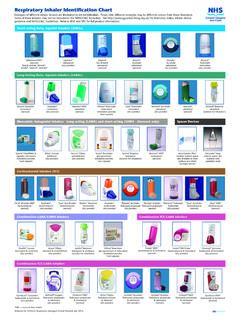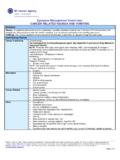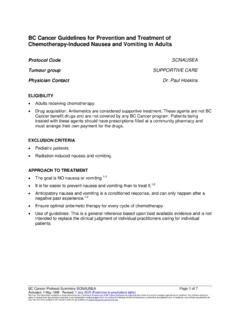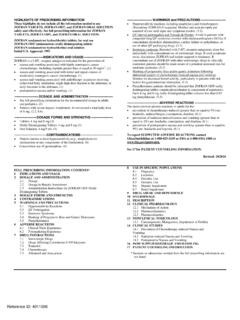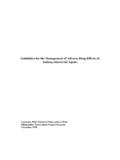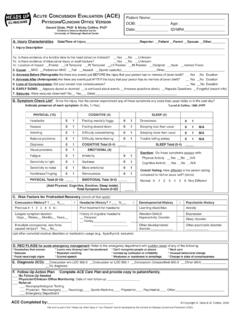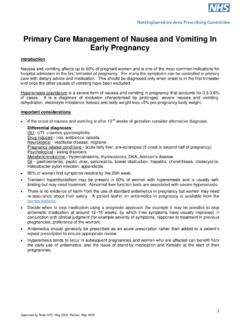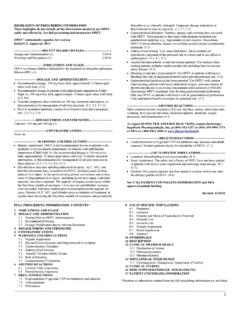Transcription of DRUG INDUCED QT PROLONGATION - GGC Medicines
1 Page 1 Issue 8, July 2018 Produced by NHS Greater Glasgow and Clyde Medicines Information Service DRUG INDUCED QT PROLONGATION **NB. This bulletin supersedes Medicines Update Extra No. 2** PROLONGATION of the QT interval can lead to a life threatening arrhythmia known as torsades de pointes. Over the last few years a number of warnings have highlighted the risk of QT PROLONGATION with citalopram, domperidone, ondansetron, hydroxyzine and quinine. Extra vigilance is required by healthcare professionals to be alert to the risk of drug INDUCED QT PROLONGATION and drug interactions. Refer to flowchart and patient scenarios for further detail.
2 Background PROLONGATION of the QT interval can lead to a life threatening ventricular arrhythmia known as torsades de pointes which can result in sudden cardiac death. There are a number of widely used drugs which are known to cause QT PROLONGATION . The Medicines and Healthcare products Regulatory Agency (MHRA) has issued a number of warnings relating to drug- INDUCED QT PROLONGATION for some commonly used drugs citalopram, domperidone, ondansetron, hydroxyzine and Extra vigilance is required by healthcare professionals to be alert to the risk of drug INDUCED QT PROLONGATION and drug interactions.
3 Interactions There are three mechanisms by which drugs can interact and increase the risk of QT PROLONGATION :6 Pharmacodynamic Interaction: The concurrent use of more than one drug that prolongs the QT interval increases the risk of torsades de pointes and ventricular arrhythmia. Pharmacokinetic Interaction: Some drugs which do not prolong the QT interval themselves can increase the risk of QT PROLONGATION by affecting the metabolism of drugs that do. Commonly used examples of this include antifungals which inhibit the CYP3A4 enzyme.* *Lists of drugs known to inhibit or induce liver enzymes can be found in Stockley s Drug Interactions here Effects on Electrolytes: Hypokalaemia and hypomagnesaemia can increase the risk of QT PROLONGATION diuretics causing hypokalaemia can increase the risk of QT PROLONGATION especially when given with QT prolonging drugs.
4 What is a normal QT interval? The QT interval varies with heart rate. A number of formulas are used to correct the QT interval for heart rate. Once corrected it is expressed as the QTc interval. The QTc interval is reported on the ECG printout. The QTc is commonly normalised to a heart rate of 60bpm and may be inaccurate in patient with faster or slower heart rates. Normal QTc Interval <450 ms in males and <460 ms in females7 What is considered to be a prolonged QT interval? The QTc interval is a surrogate marker of proarrhythmic risk and literature differs with regard to the QTc interval that would raise concern over development of arrhythmias.
5 As a guide: Borderline prolonged QTc interval >450 ms but <500 ms in males >460 ms but <500 ms in females7 Although literature differs, a QTc interval within these values is considered borderline prolonged. Consideration should be given to dose reduction of QT prolonging drugs or changing to an alternative non QT prolonging drug. Prolonged QTc Interval >500 ms in males and females A QTc interval >500 ms is clinically significant and likely to confer an increased risk of arrhythmia. Any drugs which prolong the QT interval should be reviewed immediately. 6,8,9,10 Interpretation of the QT interval on an ECG is not always straightforward and the value noted on the computerised printout may not always be accurate.
6 The following website gives some guidance on interpretation of the QT interval: FANS website What is considered a significant drug INDUCED change in QTc interval? The degree by which a drug changes the QTc interval from baseline is also important. An increase in baseline QTc of less than 5 ms is not considered significant and this is the threshold for regulatory concern. For drugs that increase the QTc interval by less than 20 ms the data is inconclusive with regard to arrhythmic risk. A change in baseline QTc of >20 ms should raise concern and a change of >60 ms should raise greater concern regarding the potential for Experience in long QT syndrome indicates that for every 10 ms increase in QTc interval there is a 5-7% increase in the risk of arrhythmic ,11 Drug INDUCED QT PROLONGATION is often dose related.
7 For example, citalopram 20 mg daily has been shown to cause a mean change in baseline QTc interval of ms; this increases to ms with citalopram 60 mg daily (unlicensed dose).1 A drug INDUCED increase in QTc interval should be assessed in conjunction with the overall QTc interval. Page 2 A list of Medicines known to prolong the QT interval can be found at (Registration is required) What are the risk factors for QT PROLONGATION ? In individual cases of torsades de pointes there are often multiple risk factors present.
8 The main risk factors which should be considered are:10-13 Potentially Modifiable Electrolyte disturbances (in particular hypokalaemia, hypomagnesaemia and more rarely hypocalcaemia). Consider the risk of electrolyte disturbance if the patient has diarrhoea/vomiting Bradycardia Concomitant use of more than one drug that prolongs the QT interval Non-modifiable Congenital long QT syndrome Cardiac disease (of multiple origins, including congestive heart failure, ventricular hypertrophy, recent conversion from AF, myocardial infarction) Impaired hepatic/renal function (due to effects on drug metabolism) Thyroid disease (more common with hypothyroidism and usually normalises with treatment13)
9 Female sex Age over 65 years What medications can cause QT PROLONGATION ? It is not possible to include a full list of all Medicines known to increase the QT interval in this bulletin. A list of medications known to prolong the QT interval can be found in the Credible Meds website This is an American website which categorises drugs based on their risk. It is recommended that you check the lists for drugs commonly used in your area of practice to familiarise yourself with the risks. This site requires registration in order to gain access to the lists (registration is free).
10 It is advised that you set up registration and become familiar with the site. Alternatively, you can access a table from Stockley s Drug Interactions Print versions of the BNF contain a table with a list of drugs that prolong the QT interval within Appendix 1, In addition to familiarising yourself with these sources, the BNF and Summary of Product Characteristics should be checked for individual drug contra-indications, cautions and interactions. Some of the more commonly encountered Medicines known to prolong the QT interval are listed in table 1. These Medicines are listed by CredibleMeds as known to have a risk of torsades de pointes or are described as high risk in Stockley s Drug interactions.

